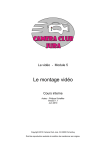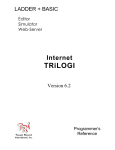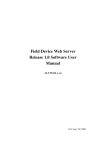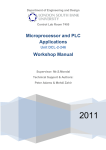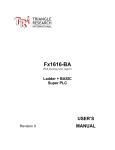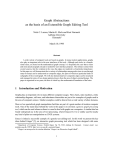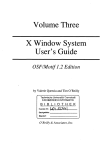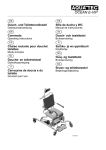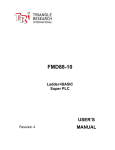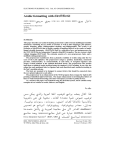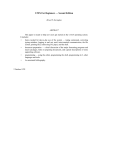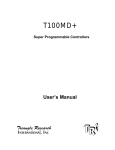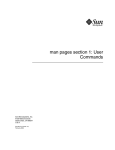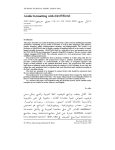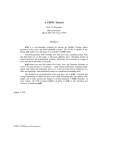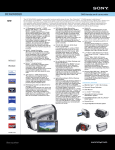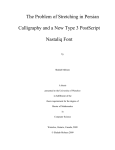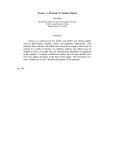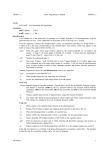Download grohtml
Transcript
G. MULLEY and W. LEMBERG: EXTENDING GNU TROFF TO PRODUCE HTML EXTENDING GNU TROFF TO PRODUCE HTML THROUGH THE TECHNIQUE OF NEXT EVENT SIMULATION GAIUS MULLEY and WERNER LEMBERG School of Computing, University of Glamorgan, CF37 1DL, UK E-Mail: [email protected] Kl. Beurhausstr. 1, 44137 Dortmund, Germany E-Mail: [email protected] Abstract: This paper reports on a technique used to generate accurate HTML output from GNU Troff. GNU Troff is a typesetting package which reads plain text mixed with formatting commands and produces formatted output. It supports a number of devices and now supports the production of HTML. The paper discusses the design of the HTML device driver grohtml and modifications made to GNU Troff. The front end program troff was modified to maintain a reduced state machine which is examined each time a glyph is passed to the back end device driver (post-grohtml). Any change in system state between the production of two glyphs results in a sequence of events being passed to the device driver. There is a direct correspondence between this technique and creating a script for a next event simulation queue. Furthermore the device driver reconstructs the system state and formats the HTML according to state changes caused when processing the event queue. This technique works well, as it minimises the state information passed from front end to back end device driver whilst still preserving the high level layout of the text. Using this technique GNU Troff effectively translates input source into another mark-up language and thus this technique could be extended to translate GNU Troff documents into any of the OpenOffice supported formats. Troff has been in use for three decades now and is still actively used by authors. Troff’s biggest use, however, is to format manual pages for GNU/Linux and other UNIX like operating systems. Introducing this facility into GNU Troff provides users with the ability to translate legacy documents into HTML and in the future to a format supported by OpenOffice. Keywords: groff, troff, grohtml, HTML, simulation. table [Lesk, 1976a], picture [Kernighan, 1991, Wyk, 1982] and equation handling [Kernighan, 1977, Kernighan, 1976] (refer, tbl, pic and eqn respectively). These programs were executed in a pipeline and troff transformed the heavily preprocessed formatting commands and text into device dependent output [Kernighan, 1978]. Although the input to troff was device independent it was also very low level and therefore users were encouraged to use macro sets when producing documents [Lesk, 1976b]. During the 1980s the internals were modestly revised and a number of new macro sets were written [Allman, 1980, Smith, 1980]. The macro sets provided freedom in document styling (similar to modern HTML style sheets) and they included: arbitrary style headers and footers; arbitrary style footnotes; automatic sequence numbering for paragraphs, sections, etc; multiple column output; dynamic font and point-size control; arbitrary horizontal and vertical local motions at any point; mathematical bracket construction, and line drawing functions [Ossanna, 1992]. INTRODUCTION GNU Troff is a reimplementation of the program troff which is available on the UNIX operating system. The original troff was written in PDP-11 assembly language by Joe Ossanna in 1973. Two years later it was rewritten in C and afterwards it went through a series of revisions until Joe Ossanna died in 1977. Brian Kernighan continued troff development for the next 15 years and it is testament to the original design that the input language remained the same. Much of the original documentation received minor changes as new troff releases were issued and therefore Joe’s name was retained on these manuals [Ossanna, 1992]. Brian Kernighan modified troff so that it could produce output for a number of different typesetting devices, while at the same time retaining the same input language specification. The input language was so robust that a number of preprocessors were written to provide reference [Tuthill, 1986], I.J. of SIMULATION Vol. 6 No 7-8 During the 1980s troff was extended to handle many different devices, this was accomplished by 37 ISSN 1473-804x online, 1473-8031 print G. MULLEY and W. LEMBERG: EXTENDING GNU TROFF TO PRODUCE HTML splitting the task of troff into two components. The front end ditroff produced device independent code and the back end device driver which simply translated the device independent code into the target device commands. commands to format abstracts, titles, footnotes, paragraphs, lists, hanging indents etc. Consequently, translating troff input source into HTML cannot be achieved by writing a device driver which simply reads ditroff input and produces HTML output. Consider the diagram in figure 1 which shows the key components of a simple groff command line invocation together with a synopsis of the data passing though the pipeline. In figure 1 the troff input consists of requests or calls to macros (lines prefixed with a period) and text. Troff input might also include text with escapes, for example the word program can be typeset by temporarily reducing the point size by 1 and altering the font to Courier. The word and escapes can be encoded as \s-1\fCprogram\s+1\fP. In figure 1 the final output is PostScript (the default device) and the invocation also includes the ms macro package. Figure 2 shows how a PostScript printer interprets the output from Figure 1. James Clark began to work on the GNU implementation of the troff family of tools in 1989. This was to be a completely new implementation of all the preprocessors, the ditroff program and the macro sets. The first release of groff (version 0.3.1) occurred in June 1990 and it included a replacement for ditroff, eqn, tbl and pic. It also included a replacement for the me macros and the man macros. The replacement programs were mostly written in C++ and often supported extensions and removed various static data size limitations. Since 1999 the groff package has had new maintainers and has undergone active development. It supports the common macro sets associated with troff (man, me, ms, mdoc and mm). However groff also provides a modern macro set (mom) and also provides new preprocessors and support for colour. A basic title DESCRIPTION OF THE PROBLEM 1. Heading at level 1 1.1. Heading at level 2 Troff was widely used in the 1970s and 1980s. All UNIX documentation, release notes for both the AT&T and BSD UNIX variants was written in troff. Many papers in the CACM and Software Practice and Experience journals were also produced using troff. Even today all UNIX and GNU/Linux manual pages are written in troff using the man macro set and some authors advocate using troff above other WYSIWYG tools to typeset their books [Tanenbaum, 1997, Stevens, 1998, Schaffter, 2004]. 1.1.1. Heading at level 3 First paragraph body Figure 2: displaying the PostScript output Notice how the ditroff output only knows which font is to be used, the font size and position that the glyph should be placed. Another example that an HTML device driver must translate accurately is shown in figure 3. The start of an indented paragraph example in which line 1, line 2 and line 3 are vertically aligned. .LP .IP once line 1 .IP twice line 2 .IP threefold line 3 Groff provides compatibility with troff as well as many modern enhancements, image handling, colour and limited pdf mark capability. Clearly the addition of an HTML device driver would be useful. GNU Troff copied the original design of UNIX Troff , which maps the input source onto a physical device through the use of a device independent language. Through this language it effectively plots each glyph at Cartesian coordinate position on a page. The difficulty in translating troff source into HTML is exacerbated by the fact that both HTML and troff source are mark-up languages. As the GNU Troff and original UNIX Troff packages rely heavily on the pipeline principle it has naturally led to the preprocessors (pic, tbl and eqn) translating their high level commands onto much lower level troff commands. In turn, this has meant that much of the high level information (for example where a table starts and ends) is lost. Furthermore, using any of the macro packages will result in many low level I.J. of SIMULATION Vol. 6 No 7-8 Figure 3: examples of indented paragraphs Here we see from the output shown in figure 4 that the ms macro set diverted the indented paragraph label parameter once, twice and threefold into a macro. It then tests to see whether the macro width is greater than a default length and if so it breaks the line before starting the indented paragraph. Clearly the HTML device driver needs to cope with these constructs, as they are also heavily used in manual pages. 38 ISSN 1473-804x online, 1473-8031 print G. MULLEY and W. LEMBERG: EXTENDING GNU TROFF TO PRODUCE HTML Troff source ditroff intemediate language postscript output .TL A basic title x T ps %!PS-Adobe-3.0 x res 72000 %%Creator: groff .NH 1 x init Heading at level 1 troff -ms %%DocumentNeed grops p1 %%+font Times-Ro .NH 2 x font 6 TB %%DocumentSupp Heading at level 2 f6 %%Pages: 1 .LP s12 H123k V 123k %%PageOrder: Asc First paragraph tA %%Orientation: body wh3000 tbasic %%EndComments Figure 1: Simple title, heading and paragraph For example HTML has a restricted set of mathematical glyphs and it is restricted in its ability to accurately position these glyphs [Musciano, 1998]. Groff in contrast can be used to typeset mathematical formulae and users will at least expect the groff HTML device driver to reproduce the formulae as an image. Figure 7 shows Troff input, which describes the definite integral. The start of an indented paragraph example in which line 1, line 2 and line 3 are vertically aligned. once line 1 twice line 2 threefold line 3 Figure 4: result of processing figure 3 with groff -ms Furthermore many documents will include encapsulated PostScript as shown in figure 5. The processed output is shown in figure 6. The issue here is that PostScript has become the default device driver and groff allows encapsulated PostScript to be handled as a special device case. Nevertheless this feature is so useful and it would be expected to be implemented in the HTML device driver. Groff also allows users to embed their own PostScript inside Troff source files (a technique similar to inlining assembly language within a high level language). In both cases users could reasonably expect the HTML device driver to translate the PostScript into a PNG image which is referenced by the HTML output. .EQ delim $$ .EN .LP As $ delta x -> 0 $ then .EQ sum from x=a to b y . delta x ˜ approx ˜ \ int from a to b y ˜ dx .EN Figure 7: eqn example When processed with the command groff -e -ms it produces the output as shown in figure 8. As δ x → 0 then .TL An example of encapsulated PostScript .LP .PSPIC -L tiger.eps 1i 1i b a Figure 5: example of encapsulated PostScript usage Figure 8: output of figure 7 as rendered on a PostScript device An example of encapsulated postscript Finally the troff language is very rich in commands and requests. The language has the ability to construct macros at run time and it does this by diverting text and commands into a diversion. Some authors of macro sets perform some highly impressive programming tricks using this technique. For example this technique has been used in the ms macro set to handle the IP request and the TL request seen earlier. It is also used to manage abstracts, authors names and references for papers. The problem is that when troff generates the Figure 6: result of processing figure 5 with groff -ms A further problem which needs to be addressed is the limited number of glyphs available in HTML. I.J. of SIMULATION Vol. 6 No 7-8 b Σ y. δ x ≈ ∫ y dx x=a 39 ISSN 1473-804x online, 1473-8031 print G. MULLEY and W. LEMBERG: EXTENDING GNU TROFF TO PRODUCE HTML ditroff output the meaning of the text is lost. The HTML device driver needs to know whether a line extensible troff translator which translates troff files into HTML-2.0. It supports the me, ms, and man macro sets as well as the front end preprocessors tbl and eqn. This is an ambitious project and it has been successful in translating manual pages and troff documents. The success is partly due to unroff understanding many of the underlying troff requests and having extra tag information inside its macro set descriptions. The main disadvantages to unroff are that it does not have a seamless interface to the pic preprocessor and currently it does not handle encapsulated PostScript or diversions. was centred, if the line was indented, when the centring ends, when indentation ends, when text is a section heading and when text is a title. It cannot guess this reliably by examining the glyph position and font information. Conveying the indentation information to the device driver is particularly difficult as diversions can be created to manipulate this value when the diversion is re-read. Consider the example given in figure 9. .LP .di foo .br .in +1i hello .in -1i .br .di .in +2i .br .foo .in +1i .br .foo The doclifter project [Raymond, 2005a] provides a means whereby many documents written in mm, ms, me and mdoc can be translated into XML-Docbook [Walsh, 1999]. Eric Raymond designed doclifter to operate at the semantic level and he acknowledges that to do a really good job requires some human polishing. Nevertheless doclifter has successfully translated 95% of all manual pages in Fedora Core 3. Doclifter translates tbl tables into DocBook table markup and pic input into SVG, however eqn is not translated. Figure 9: diversion and indentation example When processed with the command groff -ms it produces the output as shown in figure 9. hello OVERVIEW OF GROHTML The approach taken by the authors in the design of grohtml was to modify the front end groff binary so that when the HTML device is requested the troff input is run through the PostScript device driver and later through the HTML device driver. All images are created by converting the relevant PostScript page into a bitmap image after which the required area is cut and converted into the PNG [Roelofs, 1999] format. The pipeline structure is outlined in figure 11. The preprocessors tbl, eqn and pic were modified to indicate where the start and end of a table, equation and picture occur. This information is then transparently read by the front end and determines the area of the bitmap file which is required for an image. The advantage of this approach is that grohtml can fully support encapsulated PostScript inclusion and it also allows users to use this feature together with any combination of glyphs to generate web images. hello Figure 10: output of figure 9 as rendered on a PostScript device Clearly an HTML device driver must also understand the diversions sufficiently so that the important formatting requests are accurately translated. PREVIOUS WORK There have been a number of scripting solutions implemented which translate troff documents into HTML. These scripts operate at the macro set level and they independently translate the functionality of the various macros into HTML. For example scripts exists to translate the ms macros IP, TL, LP, PP, DS into indented paragraph; title; left aligned paragraph; paragraph and block text. The advantage of this approach is its simplicity but the disadvantages are that the scripts need to be maintained independently to the corresponding macro set and more importantly the scripts do not understand user defined macros. Often these scripts do not honour all the macro optional arguments or allow inclusion of encapsulated PostScript. The macro sets ms and man were also slightly modified to issue a tag when troff encounters a section heading, title or indented paragraph. All tags are emitted together with the ditroff intermediate code to the device driver post-grohtml. The troff program was also modified to handle another escape \O which has five variants and they are described in table 1. These escapes are Another solution is unroff [Laumann, 1996], which is a Scheme-based, programmable and I.J. of SIMULATION Vol. 6 No 7-8 40 ISSN 1473-804x online, 1473-8031 print G. MULLEY and W. LEMBERG: EXTENDING GNU TROFF TO PRODUCE HTML users troff document Definite integral .EQ sum from x=a to b... .EN p r e g r o h t m l groff -ms -e -Tps -rps4html=1 generate images from PostScript file intemediate PostScript output image coordinates 1 png images groff -Thtml -e -ms -Z 2 3 post HTML grohtml output Figure 11: the groff -Thtml -ms -e pipe line Escape \O0 \O1 \O2 \O3 \O4 \O[5P filename] Meaning Disable any glyphs from being emitted at the outer level. † Enable output of glyphs, provided that the escape occurs at the outer level. † Providing the escape occurs at the outer level, enable output of glyphs and also write out to stderr the page number and four registers encompassing the glyphs previously written since the last call to \O. Begin a nesting level. End a nesting level. HTML device specific. Provided that this escape occurs at the outer nesting level write the filename to stderr. The position of the image, P, must be specified and must be one of l, r, c or i (left, right, centre, inline). Table 1: new troff escapes and their meaning important as they allow preprocessors to tell troff to skip a block of text or issue a box of coordinates which define the area for a set of glyphs. This functionality is used during the PostScript pass to determine the region used by a table, picture or equation. Conversely it is used by the HTML pass to stop producing glyphs when a table, equation or picture is encountered; but replace these items with an HTML reference to an image. Whenever a glyph is about to be written in the ditroff output, troff needs to check whether this state has changed since the last glyph was written. If the state has changed then troff emits a series of tags which define the change in state. There is clear correspondence between tags appearing in the ditroff intermediate output and a next event queue albeit without any time component. The HTML driver post-grohtml reconstructs the system state according to the events it reads and in the process translates the glyphs into HTML text surrounded by the appropriate HTML tags [Musciano, 1998]. Furthermore troff can handle requests read from diversions by pushing the current minimal HTML state before a diversion is read and popping it later once the diversion has finished. This allows diversions to centre lines, alter the indentation, and emit preformatted text, whilst restoring the state once the diversion has ended. STATE MACHINE SOLUTION If grohtml is implemented as described in the last section it will be able to translate all: encapsulated PostScript, tbl, pic, eqn, section headings, numbered headings and titles accurately. However it will still fail to accurately translate: centred lines, any indentation, preformatted blocks, tabulated text, line breaks and vertical spaces. A solution to this problem is to extend the repertoire of tags which are passed from troff to post-grohtml. This requires further modification to the troff so that it will issue tags whenever the above formatting requests are encountered. In essence the back end of troff maintains a simple state machine which represents the minimum information required to correctly reproduce the formatting requests listed above. I.J. of SIMULATION Vol. 6 No 7-8 The complete set of tags which post-grohtml understands is shown in table 2. Figure 16 shows the extended ditroff output when GNU Troff processes Figure 9. The command line to generate this † Both \O0 and \O1 reset four troff registers which mark the top left and bottom right hand corners of an area containing all written glyphs. 41 ISSN 1473-804x online, 1473-8031 print G. MULLEY and W. LEMBERG: EXTENDING GNU TROFF TO PRODUCE HTML into HTML and images and figure 15 shows that indentation within diversions behave correctly. information is shown below: groff -Z -ms -Thtml ex9.n At present the GNU Troff macro sets: ms, man, and mwww have the extra HTML tags included. Figure 17 shows the output of a component from the GNU pic and the output in Figure 16 contains the minimum tags necessary in order to convey the meaning of the glyph formatting. The example shown in figure 9 produces two lines with a single word hello on each line. The first line hello is indented at three inches and on the second line hello is indented at four inches. The example starts by declaring a left adjusted paragraph .LP and then it creates the diversion .di foo. All subsequent text and requests are diverted into foo until the second .di is encountered. The next request .in +2i informs the typesetter that an indentation of two inches is required. When .foo is encountered it rereads the diversion which performs another relative indent of one inch before emitting the glyph hello. The diversion then reduces the indentation by one inch before finishing. Textual input is resumed after the diversion .foo at the request .in +1i which performs a relative indent of one inch (at this point the indentation is set at three inches). Lastly the diversion is run again which emits the final hello four inches from the left hand margin. guide [Raymond, 2005b] when processed through the following pipeline. groff -pet -ms -Thtml pic.ms | html2ps -s2 It can be seen that grohtml correctly determines that the equation is inside a picture and generates one image. Figure 18 shows the grohtml manual page after it was processed by the pipeline: groff -pet -man -Thtml grohtml.man and viewed through a browser. In this case we can clearly see the vertical alignment correctly represented between lines which contain a command line option and those lines which are a component of a hanging paragraph. Figure 19 shows how the GNU Troff homepage appears when printed from a browser. The homepage was created by the following command line. groff -pet -ms -Thtml webpage.ms Figure 16 shows the ditroff output together with an annotated description. It also shows extensions made to ditroff which include the extra tag information (lines starting with x X devtag: convey the minimum events necessary such that post-grohtml can reconstruct the troff state machine. As post-grohtml reconstructs the state machine it generates the appropriate HTML. Critically for this example it can be seen that here are only two x X devtag:.in events, one at 3 inches and the second at 4 inches, despite the example in figure 9 having four .in requests. The file webpage.ms make extensive use of the mwww macro set which provides drop capital, unordered line list, URL and image related macros. It also makes use of colour which was recently added to GNU Troff. CONCLUSIONS AND FURTHER WORK In conclusion the grohtml device driver has been constructed and integrated into groff. This work has taken six years of part time effort and amounts to approximately 9600 lines of C++ code (not including macro set modifications). In due course the groff-1.19.2 will be formally released and this will be the first beta release of grohtml. During the development of grohtml a number of additional features were needed to produce useful HTML. These features were applied generically as possible and include the introduction of colour. Colour is now supported by the ASCII, PostScript, HTML, and DVI devices. GNU pic has also been extended to support colour. EXAMPLES OF GROHTML OUTPUT The examples shown in this section were produced with groff version 1.19.2 and the test cases are those from figures 3, 5, 7 and 9. All the examples were constructed using the following pipeline: groff -Thtml html2ps -e -ms filename.ms | and these are shown in figures 12, 13, 14 and 15 respectively. The test results appear satisfactory and show that the indentation using the IP macro works as expected. This macro uses a diversion to detect the width of its first argument before emitting the paragraph. The example shows how each line 1, line 2 and line 3 are vertically aligned. Notice that line 3 has a vertical space between itself and threefold. Figure 13 shows that groff can translate eqn input I.J. of SIMULATION Vol. 6 No 7-8 The principles behind the HTML device driver appear sound, however there are still minor bugs in grohtml. Future work will include bug fixing and also modifications to tbl so that troff tables can be translated into HTML <table> constructs rather than an image. The remaining macro sets (mm, me, mdoc and mom) will also be updated to include the devtag requests necessary for grohtml to detect 42 ISSN 1473-804x online, 1473-8031 print G. MULLEY and W. LEMBERG: EXTENDING GNU TROFF TO PRODUCE HTML section headings, titles and indented paragraphs. Tag Description As the OpenOffice file formats are fully published it should be possible to construct a new GNU Troff device driver (grodoc) which utilizes the extended ditroff intermediate language. This new device driver could be built using a similar design to that of grohtml. .SH .NH .col n .eo.h .tl .eo.tl .fi n start of section heading start of numbered heading start of column n end of heading start of title end of title if n is 0 then treat as preformatted text vertical line space indent next line n units line is n units long left offset is n units list defines the tab settings next line is temporarily indented n units centre next n lines end of input line line break forced ACKNOWLEDGEMENTS .sp .in .ll .po .ta .ti The authors would like to thank all the readers and contributors of the groff mailing list for their patience with this project and also for their many valuable bug reports over the last six years. We would also like to thank our respective employers for funding our time while we were working on groff. n n n list n .ce n .eol .br Finally a great debt of thanks is owed to James Clark without whom there would be no groff. Table 2: tags passed from troff to post-grohtml The start of an indented paragraph example in which line 1, line 2 and line 3 are vertically aligned. once twice p1 V280 H240 DFd F ./ex9.n V360 H720 x X devtag:.fi x X devtag:.in x X devtag:.ll x X devtag:.po x X devtag:.ce x X devtag:.br x font 1 R f1 s10 V360 H720 md thello n40 0 V400 H960 x X devtag:.in x X devtag:.br V400 H960 thello line 1 line 2 threefold line 3 Figure 12: the result of HTML output from figure 3 An example of encapsulated postscript Figure 13: the result of HTML output from figure 5 As then Figure 14: the result of HTML output from figure 7 hello hello Figure 16: extended ditroff intermediate output Figure 15: the result of HTML output from figure 9 I.J. of SIMULATION Vol. 6 No 7-8 page 1 vertical resolution 280 units/inch horizontal resolution 240 units/inch default background colour input file ex9.n move to vertical position 360 units move to horizontal position 3 inches 1 word wrap is on 720 3 inch indentation 1440 line length is 6 inches 0 page offset 0 inches 0 centre lines is off line break times roman font indexed as the first font use times roman font point size 10 move to vertical position 360 units move to horizontal position 3 inches default foreground colour emit glyph hello emit space move to vertical position 400 units move to horizontal position 4 inches 960 4 inch indent requested line break requested move to vertical position 400 units move to horizontal position 4 inches emit glyph hello 43 ISSN 1473-804x online, 1473-8031 print G. MULLEY and W. LEMBERG: EXTENDING GNU TROFF TO PRODUCE HTML 17.4. PIC and EQN Home of Groff (GNU Troff). The Kernighan paper notes that there is a subtle problem with complicated equations inside pic pictures; they come out wrong if eqn(1) has to leave extra vertical space for the equation. If your equation involves more than subscripts and superscripts, you must add to the beginning of each equation the extra information space 0. He gives the following example: file:///home/gaius/GNU/groff-html/doc/webpage.html GNU Troff (Groff) — a GNU project. HE groff (GNU Troff) software is a typesetting package which reads plain text mixed with formatting commands and produces formatted output. Groff now supports HTML. Download arrow box "$space 0 {H( omega )} over {1 - H( omega )}$" arrow The source code of the currently released versions of groff is available at the FFII host (Germany), GNU host (USA), and its mirrors. The USA site also contains older, obsolete versions. The most actual pre-release, development version is available from a CVS repository, see below. Development snapshots (produced twice a day from the CVS repository) can be downloaded from here. For a special version of groff on the Microsoft operating systems, see Groff for Windows. GNU troff is released under the GNU Copyright License. User issues lead: Ted Harding. Technical issues lead: Werner Lemberg. Figure 17-1: Equations within pictures README Figure 17: extract from "Making Pictures With GNU PIC" by Eric S. Raymond GROHTML This is the GNU groff document formatting system. The version number is given in the file VERSION. Included in this release are implementations of troff, pic, eqn, tbl, grn, refer, −man, −mdoc, and −ms macros, and drivers for PostScript, TeX dvi format, HP LaserJet 4 printers, Canon CAPSL printers, HTML format (beta status), and typewriter-like devices. Also included is a modified version of the Berkeley −me macros, an enhanced version of the X11 xditview previewer, and an implementation of the −mm macros contributed by Jörgen Hägg . file:///home/gaius/GNU/groff-html/src/devices/grohtml/t.html See the file INSTALL for installation instructions. You will require a C++ compiler. GROHTML The file NEWS describes recent user-visible changes to groff. NAME OPTIONS 1 of 18 NAME grohtml − html driver for groff OPTIONS −a aa-text-bits Number of bits of antialiasing information to be used by text when generating png images. The default is 4 but valid values are 0, 1, 2, and 4. Note your version of gs needs to support the −dTextAlphaBits and −dGraphicAlphaBits options in order to exploit antialiasing. A value of 0 stops grohtml from issuing antialiasing commands to gs. −b Initialize the background color to white. −D dir Inform grohtml to place all image files into directory dir. 20/05/05 23:55 Figure 19: GNU Troff homepage when printed from a browser REFERENCES Allman Eric P. 1980, Writing Papers with NROFF using −me, University of California, Berkeley, Berkeley, California 94720. −F dir Prepend directory dir/devname to the search path for font and device description files; name is the name of the device, usually html. −g aa-graphic-bits Number of bits of antialiasing information to be used by graphics when generating png images. The default is 4 but valid values are 0, 1, 2, and 4. Note your version of gs needs to support the −dTextAlphaBits and −dGraphicAlphaBits options in order to exploit antialiasing. A value of 0 stops grohtml from issuing antialiasing commands to gs. Kernighan Brian W. 1991, “PIC — A Graphics Language for Typesetting,” Revised User Manual, 116, Bell Labs Computing Science Technical Report. Kernighan Brian W. 1978, A TROFF Tutorial, P. 13, Bell Laboratories, Murray Hill, New Jersey 07974. 1 of 1 Kernighan Brian W. and Cherry Lorinda L. 1977, A System for Typesetting Mathematics, Bell Laboratories, Murray Hill, New Jersey 07974. 21/05/05 00:19 Figure 18: grohtml manual page showing vertical alignment of hanging paragraphs Kernighan Brian W. and Cherry Lorinda L. 1976, Typesetting Mathematics User’s Guide, Bell Laboratories, Murray Hill, New Jersey 07974. Laumann Oliver 1996, Unroff - programmable, extensible troff translator. http://wwwrn.informatik.uni-bremen.de/software /unroff. Lesk M. E. 1976, Tbl — A Program to Format Tables, Bell Laboratories, Murray Hill, New Jersey 07974. I.J. of SIMULATION Vol. 6 No 7-8 44 ISSN 1473-804x online, 1473-8031 print G. MULLEY and W. LEMBERG: EXTENDING GNU TROFF TO PRODUCE HTML Lesk M. E. 1976, Typing Documents on the UNIX System: Using the −ms Macros with Troff and Nroff, Bell Laboratories, Murray Hill, New Jersey 07974. Werner Lemberg (born 1968 in Vienna, Austria) is working as a conductor and singers’ coach at the municipal theatre of Koblenz, Germany. In his spare time he maintains the groff package and actively develops the FreeType font rendering library. Musciano Chuck and Kennedy Bill 1998, HTML The definitive guide, Third Edition, O’Reilly & Associates. ISBN 1-68592-492-4. Ossanna Joseph F. and Kernighan Brian W. 1992, Nroff/Troff User’s Manual, Bell Laboratories, Murray Hill, New Jersey 07974. Raymond Eric S. 2005, Doclifter. http: //www.catb.org/˜esr/doclifter. Raymond Eric S. 2005, Making Pictures With GNU PIC. ftp://ftp.gnu.org/gnu/groff/. Roelofs Greg 1999, PNG The Definitive Guide, First Edition, O’Reilly & Associates. ISBN 1-56592-542-4. Schaffter Peter 2004, The Schumann Napoleon Publishing. ISBN 1-89491-706-5. Proof, Smith D. W., Mashey J. R., Pariser E. C. and Smith N. W. 1980, MM — Memorandum Macros, Bell Laboratories internal memorandum, Murray Hill, New Jersey 07974. Stevens Richard W. 1998, UNIX Network Programming, 1, P. xx, Prentice-Hall International. Tanenbaum A.S. 1997, Computer Networks, 3rd Edition, Prentice-Hall. Tuthill Bill 1986, Refer — A Bibliography System, Computing Services, University of California, Berkeley, CA 94720. Walsh Norman and Muellner Leonard 1999, DocBook: The Definitive Guide, First Edition, O’Reilly & Associates. ISBN: 1-56592-580-7. Wyk C. J. Van 1982, “A high-level language for specifying pictures,” ACM Transactions On Graphics, 1(2), Pp. 163-182. BIOGRAPHY OF AUTHORS Gaius Mulley is a senior lecturer at the University of Glamorgan. He is the author of GNU Modula-2 and the groff HTML device driver grohtml. His research interests also include performance of microkernels and compiler design. He obtained a BSc(Hons) and PhD in Computer Science from the University of Reading and later worked for Meiko Scientific. I.J. of SIMULATION Vol. 6 No 7-8 45 ISSN 1473-804x online, 1473-8031 print









